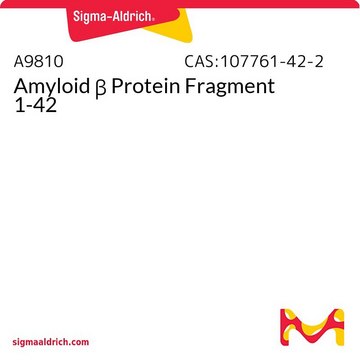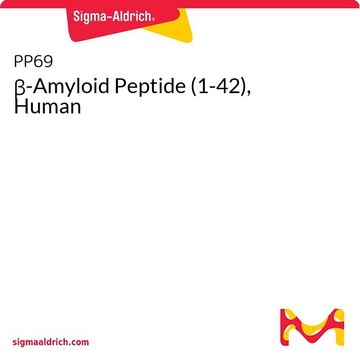Wichtige Dokumente
A2201
Amyloid β-Protein Fragment 35-25
≥95% (HPLC)
About This Item
Empfohlene Produkte
Qualitätsniveau
Assay
≥95% (HPLC)
Form
powder
UniProt-Hinterlegungsnummer
Lagertemp.
−20°C
SMILES String
CCC(C)C(NC(=O)CNC(=O)C(CC(C)C)NC(=O)C(N)CCSC)C(=O)NC(C(C)CC)C(=O)NC(C)C(=O)NCC(=O)NC(CCCCN)C(=O)NC(CC(N)=O)C(=O)NC(CO)C(=O)NCC(O)=O
InChI
1S/C45H81N13O14S/c1-9-24(5)36(57-34(62)20-50-40(67)29(17-23(3)4)54-39(66)27(47)14-16-73-8)45(72)58-37(25(6)10-2)44(71)52-26(7)38(65)49-19-33(61)53-28(13-11-12-15-46)42(69)55-30(18-32(48)60)43(70)56-31(22-59)41(68)51-21-35(63)64/h23-31,36-37,59H,9-22,46-47H2,1-8H3,(H2,48,60)(H,49,65)(H,50,67)(H,51,68)(H,52,71)(H,53,61)(H,54,66)(H,55,69)(H,56,70)(H,57,62)(H,58,72)(H,63,64)
InChIKey
IDGOADDOQWKZOX-UHFFFAOYSA-N
Angaben zum Gen
human ... APP(351)
Amino Acid Sequence
Allgemeine Beschreibung
Anwendung
Biochem./physiol. Wirkung
Sonstige Hinweise
Lagerklassenschlüssel
11 - Combustible Solids
WGK
WGK 3
Flammpunkt (°F)
Not applicable
Flammpunkt (°C)
Not applicable
Persönliche Schutzausrüstung
Eyeshields, Gloves, type N95 (US)
Hier finden Sie alle aktuellen Versionen:
Besitzen Sie dieses Produkt bereits?
In der Dokumentenbibliothek finden Sie die Dokumentation zu den Produkten, die Sie kürzlich erworben haben.
Kunden haben sich ebenfalls angesehen
Unser Team von Wissenschaftlern verfügt über Erfahrung in allen Forschungsbereichen einschließlich Life Science, Materialwissenschaften, chemischer Synthese, Chromatographie, Analytik und vielen mehr..
Setzen Sie sich mit dem technischen Dienst in Verbindung.






